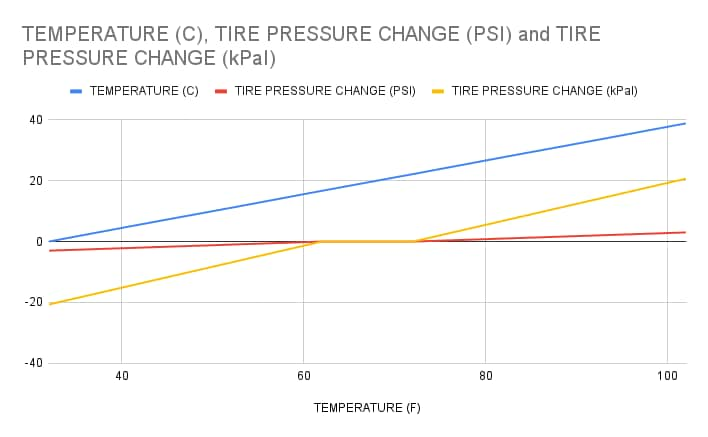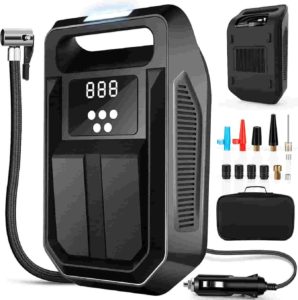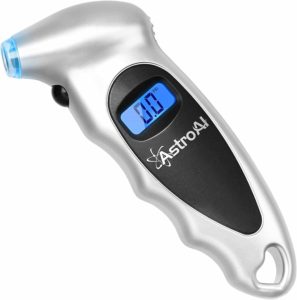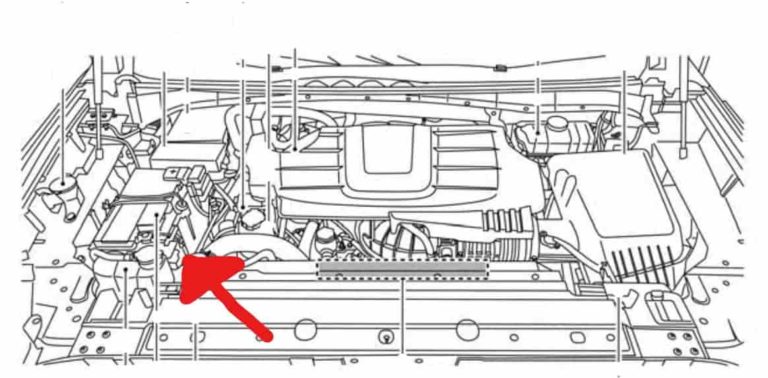What is the Tire Pressure Monitroing System in the Nissan Titan?
Welcome to our comprehensive guide on how to manage the tire pressure light on your 2023 Nissan Titan. This truck doesn’t have a tire pressure reset button, but don’t worry, we’ve got you covered. From adjusting tire pressure to resetting the entire system, we’ll walk you through the steps to ensure your Titan is running smoothly and safely. We’ll also dive into the workings of the Tire Pressure Monitoring System (TPMS), discuss how weather affects tire pressure, and provide tips on tire maintenance. Whether you’re dealing with a stubborn tire light or just want to understand your Titan better, this guide is for you. Let’s get started!
How to Reset the Nissan Titan Tire Pressure Light
The Nissan Titan does not have a tire pressure reset button.
Park the vehicle in a safe place and turn the engine off.
Adjust the tire pressure in all four tires to the recommended COLD tire
Drive the truck at speeds above 16 MPH (25 km/h) for a few miles. The low tire pressure warning light does not automatically turn off when the tire pressure is adjusted, the Titan needs to be driven for the sensors to read the new pressure levels.
If the low tire pressure warning light flashes for approximately 1 minute and then remains on after you turn the ignition switch to the ON position, the TPMS is not functioning properly. (read more about TPMS malfunction below)
If the light doesn’t go off right away, re-check your tire pressure to make sure they are all at the exact pressure you set them to. If the pressure has decreased, you probably have some sort of leak in that tire.
If your tires are not losing air and the tire light still won’t go out, try overfilling your tires by about 10 Psi. So, fill them to 45 – 50 Psi and then drive the truck for a few minutes. The tire light should reset. Remember: DO NOT leave the tires at this level, release the extra 10 Psi afterwards.
2023 Nissan Titan Tire Pressures
TIRE SIZE | FRONT PSI | REAR PSI |
265/70R18 | 39 | 39 |
275/60R20 | 36 | 36 |
275/70R18 | 35 | 35 |
LT275/65R18 | 65 | 65 |
LT265/60R20 | 65 | 70 |
FULL SIZE SPARE | SAME | SAME |
Nissan Titan Tire Settings
How to Reset the Tire Maintenance Light
Reset the tire maintenance light after a tire rotation.
Apply the parking brake.
Turn the ignition switch to the ON position. Do not start the engine.
Use the steering wheel switches to select the “Settings” menu on the vehicle information display.
Select “Vehicle Settings“, then “Tire“, and finally “Tire Maintenance“.
Select “Reset“, then select “Yes“.
How to Change the Tire Pressure Units
Press the “MENU” button on the control panel to display the “MENU” screen.
Use the multi-directional switch to select “Settings“.
Then select “Vehicle Settings“.
After that, select “Tire Pressures“.
Finally, select the desired pressure unit (PSI, kPa, or bar).
How Does the Titan TPMS Work?
The Tire Pressure Monitoring System (TPMS) in a Nissan Titan is a tool that tells you if your tires need more air. Here’s an easy explanation of how it works:
Sensors: Each tire, including the spare, is equipped with a sensor that is attached to the valve stem inside the tire. These sensors are small electronic devices that are powered by a battery. They constantly measure the pressure inside the tire and also measure the temperature. The sensors are designed to be durable and withstand the harsh conditions inside a tire, including changes in pressure, temperature, and humidity, as well as the physical stress of driving.
Transmission of Data: The sensors transmit data wirelessly to the vehicle’s central control module, also known as the receiver module. This is done using radio frequency technology. The data transmitted includes the current pressure of each tire and also includes the temperature inside the tire. The sensors transmit data at regular intervals, or when the vehicle is in motion, or when a significant change in tire pressure or temperature is detected.
Monitoring: The control module is the computer inside the vehicle. It monitors the data received from each sensor. It compares the current tire pressure readings with the recommended tire pressure levels for the vehicle, which are programmed into the control module. The recommended tire pressure levels are set by Nissan and take into account factors such as the vehicle’s weight, size, and performance characteristics.
Warning Light: If the pressure in one or more tires drops below the recommended level, the control module triggers the TPMS warning light on the vehicle’s dashboard. This is the yellow symbol that looks like a tire cross-section with an exclamation point in it. The purpose of the warning light is to alert the driver that the tire pressure needs to be checked. The light is designed to be easily visible and grab the driver’s attention.
Maintenance: The batteries in the TPMS sensors usually work for many years, but at some point, they’ll run out. They look like simple wrist watch batteries and are sealed inside the sensor unit. When the batteries die, you can’t just replace the battery, you have to replace the whole sensor. If the TPMS warning light is blinking there is a possibility the batteries are dead or low on power.
What is the TPMS Malfunction Indicator?
The Nissan Titan’s tire pressure monitoring system also has a malfunction indicator to alert you when something is wrong with the system itself. The indicator uses the same yellow exclamation point as the low tire pressure light. The difference is that, if there is a problem with the system, the light will flash for approximately one minute before staying on. This flashing or blinking will happen every time you start your Titan until the issue is resolved. When your tire light is flashing your Titan will not be able to give you accurate pressure readings. Basically, a blinking tire pressure light means there is a malfunction within the TPMS itself, rather than an air pressure issue. This is usually due to a faulty pressure sensor in one of your tires (a dead battery) or driving with the spare tire. (if the spare doesn’t have a sensor in it) To figure out which sensor is malfunctioning or faulty, use a TPMS diagnostic tool and scan each sensor for diagnostic information or bring your truck to a professional.
What Causes a TPMS Malfunction?
Using non Nissan wheels or tires.
Electronics that use similar radio frequencies can potentially interfere with the TPMS. Such interference can originate from various sources such as radios, walkie talkies or even a nearby store’s alarm system.
If the windows on your Titan are heavily tinted, it could potentially interfere with the radio signals transmitted between the TPMS sensors and the receiver.
If there is substantial snow or ice accumulation on or surrounding the tire valves
If the tire pressure is extremely high.
If wheels without tire pressure sensors are installed on the truck.
If new tire pressure sensors are installed without registering the new sensor IDs with the Titan’s receiver module/ECU the vehicle will not recognize them.
What Causes The Tire Light to Turn On?
Seasonal temperature changes: A drop in ambient temperature can cause tire pressure to decrease, triggering the warning light.
Tire puncture or leak: A sharp object or road debris like a nail or screw may puncture a tire, causing air loss which will of course activate the warning light.
Faulty tire pressure sensor: Damaged or malfunctioning sensors may provide inaccurate readings, resulting in a false alert. The only way to determine which sensor is faulty is to scan each sensor with a TPMS diagnostic tool.
Valve stem issues: A damaged or leaking valve stem can lead to gradual pressure loss and eventual activation of the tire pressure light. They make kits to replace the rubber gasket that usually goes bad.
Tire damage: Impact from potholes or hitting a curb can cause structural damage like tire bubbles, leading to pressure loss.
Sensor battery life: TPMS sensors are battery-powered, and over time, batteries die. (they usually last anywhere from 5-10 years) This will cause the tire pressure light to turn on. Again, you must use a diagnostic tool to determine which sensor is dead or dying.
Recent tire rotation or replacement: If the tires have been recently rotated or replaced, the TPMS may need recalibration to avoid false alerts. Sometimes the vehicle’s computer may think the front tires are in the rear and rear in the front after a rotation.
Wheel or rim issues: Damaged, corroded, or cracked wheels or rims can lead to air leaks and pressure loss. This is very common with low profile tires.
Altitude changes: Climbing or descending in elevation can affect tire pressure and trigger the TPMS warning. An additional 1.5 Psi per Km above sea level is required.
Natural pressure loss: Tires lose air pressure over time due to temperature changes and permeation. Tire dry-rot will happen to tires that sit.
Electrical problems or software issues within the truck’s TPMS system. Occasionally the system may have a software update from Nissan.
Snow Tires: If you have a separate pair of wheels/rims for your snow tires, you can either transfer the sensors from your summer wheels or acquire an additional set of 4 sensors for the second pair of wheels/rims. However, if you are using the same wheels for both sets of tires, there is no need to be concerned about this.
Does the Weather Affect Tire Pressure?
In the Nissan Titan, as in all vehicles, tire pressure can be significantly impacted by weather conditions. When the weather gets colder the air inside your tires contracts, which will lead to a decrease in tire pressure. In hot weather the air inside your tires expands, causing an increase in tire pressure. These changes will impact the truck’s performance and safety. Therefore, it’s crucial for Nissan Titan owners to regularly check their tire pressure, especially when there are significant changes in weather. A general guideline suggests that for every 10-degree Fahrenheit change in temperature, tire pressure will decrease or increase by around 1 psi in the same direction.
What are the Effects of Underinflated or Overinflated Tires?
When the tires on a Nissan Titan are underinflated or overinflated, several things can happen:
Underinflated Tires:
Decreased Fuel Efficiency: Underinflated tires can lower your gas mileage, making your vehicle less fuel-efficient.
Poor Handling: The Titan may not respond as well when you steer, making it harder to control.
Increased Tire Wear: Tires that are underinflated wear out quicker, especially on the edges of the tread.
Overheating: Underinflated tires can get too hot, especially when driving at high speeds, which can lead to complete tire failure.
Overinflated Tires:
Harsher Ride: Overinflated tires are harder and can make the ride feel more bumpy, as they absorb less shock from the road because they don’t flex like they should.
Increased Tire Wear: Tires that are overinflated wear out more quickly in the middle of the tread.
Reduced Traction: Overinflated tires have less contact with the road, which reduces traction and makes the Titan more difficult to handle.
Increased Risk of Tire Damage: Overinflated tires are more susceptible to damage like blowouts and punctures especially when hitting a pothole or curb.
Is It Safe To Drive With Low Tire Pressure?
It’s usually okay to drive for a short time with the TPMS light on, but you should fix the problem as soon as you can. Driving for a long time with the wrong tire pressure can cause a lot of problems. We suggest finding out what’s causing the issue. Do you have a slow leak? Is there a screw or nail in the tire? Problems with the bead seal? Is the tire losing air slowly or quickly? Find out what’s wrong, understand the risk, and take action quickly. Always put safety first!
Identifying the Source of a Tire Leak
First, figure out which tire is low on air. Next, find a spray bottle and fill it with soap and water (windex works too). Spray down the entire tire, including the bead of the tire (where the tire meets the wheel), and the valve stem. Be sure to cover the entire tire, every inch. Wait a few seconds and inspect the entire tire for small bubbles. If air is leaking out of a tire that’s covered in soapy water, you’ll see the leak as tiny bubbles coming out of the puncture.
What is "Cold" Tire Pressure?
“Cold” tire pressure refers to the air pressure in your tires when they haven’t been driven on for a few hours and have had a chance to cool down. This is usually in the morning or after your vehicle has been parked for a while. It’s important to check your tires when they are “cold” because driving heats up the tires, causing the air inside them to expand and potentially giving a higher pressure reading. If you adjust your tire pressure based on these higher readings, you could end up overinflating your tires. Checking your tire pressure when they are “cold” gives you the most accurate reading, helping to ensure your tires are properly inflated for optimal vehicle performance and safety.
How to Adjust Tire Pressure
Make sure the tires are cold. If your vehicle has been driven, wait at least three hours before checking the tire pressure.
Remove the valve cap from the tire.
Press the tip of the tire pressure gauge onto the valve and read the pressure.
If the tire pressure is below the recommended level, fill the tire with air until the recommended pressure is reached. If the tire pressure is above the recommended level, release air until it reaches the recommended pressure. (Press the metal stem in the center of the tire valve. You can use any object like a screwdriver to do this. Be gentle.)
After adjusting the tire pressure, don’t forget to put the valve caps back on to prevent leaks and keep dirt and moisture out.
Repeat this process for each tire, including the spare if applicable.
Are Tire Plugs Safe?
Absolutely. I’ve personally plugged thousands of tires and hardly ever had any problems. Tire plugs are a safe and reliable way to fix holes in the tread part of a tire. They are designed to be inserted directly into the hole caused by things like a nail or screw, effectively sealing the puncture from any air leakage. Tire plugs are made of a durable rubber-like compound that is resistant to the harsh conditions inside a tire, including pressure and heat changes. When installed correctly a tire plug can last for the rest of the tires life without the need for a new tire. Do not use a tire plug in the sidewall of a tire.
How to Install and Calibrate New Tire Pressure Sensors
Installing new TPMS sensors into a wheel takes a few key steps. It’s usually done during tire changes. After removing the tire from the wheel, the old sensor is carefully removed. The base of the sensor is removed and then the valve stem is pulled out through the top of the wheel. Next, you can install the new sensor. It’s important to make sure the new sensor is compatible with the Nissan TPMS system. Once the new sensor is installed and the tire is mounted back on the wheel, the sensor needs to be registered to the truck’s Electronic Control Unit (ECU). This process is called TPMS “relearning”. It involves programming the new sensor’s unique ID number into the ECU so that it recognizes signals from the new sensor. (We recommend taking a picture of each new sensor’s ID number before installing them so that you have the ID number accessible) This process requires using a TPMS relearning tool. The basic idea is that you scan each of the 4 mounted sensors and then allow the tool to sync with the vehicle’s ECU.
Disconnect the Battery
If you’ve tried everything and nothing seems to work, you can disconnect the main 12-volt battery. Start with the negative terminal to avoid any short circuits (you’ll need a 10 or 12mm wrench). This will cut off power to the ECU (engine control unit), which will erase any error codes stored by the computer (The tire pressure light is an error code). Only use this method if you’ve run out of other options. Disconnecting the battery will cause the computer to lose its adaptive memory settings. This means that after you reconnect the battery, your Titan might need to go through a “relearning” process. This is when it recalibrates sensors and actuators to work at their best. To finish the relearn, drive the Titan for 30 minutes or more over 50 Mph.
Conclusion
And there you have it – a comprehensive guide to managing the tire pressure light on your Nissan Titan. We’ve covered everything from the basics of adjusting tire pressure, understanding the TPMS, to troubleshooting issues and resetting the entire system. Remember, regular tire maintenance is crucial for the safety and performance of your Titan. By following these steps, you’ll ensure a smooth ride, optimal fuel efficiency, and a longer lifespan for your tires. Drive safe and keep your tires happy! Everything in this article is applicable to all Nissan Titan and Titan XD models and trims. Including Titan 4×2 and 4×4 drivetrains as well as Titan King Cab S, Titan Crew Cab S, Titan Crew Cab SV, Titan King Cab SV, Titan Crew Cab SV Midnight Edition, Titan Crew Cab Pro-4X, Titan Crew Cab Platinum Reserve.
Please note that this blog post contains Amazon affiliate links. This means that if you make a purchase through one of these links, we at TPMSRESET.com may earn a small commission at no extra cost to you. We only recommend products that we personally use and believe in. Thank you for supporting us.







